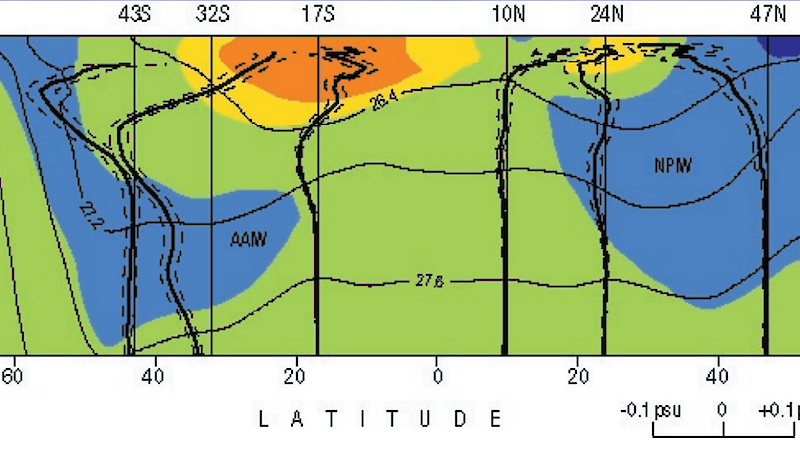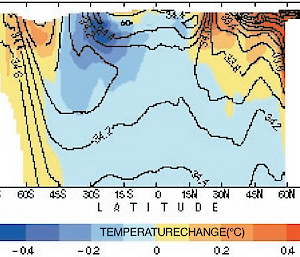Much of the debate about climate change has been about the evidence for climate change within the limited data sets that are available, and the skill of the coupled ocean-atmosphere models used to create scenarios of future climate. The World Ocean Circulation Experiment (WOCE) has produced new high quality oceanographic data that enables more detailed comparison with coupled ocean-atmosphere models in the Southern Ocean and has established modes of variation or ‘fingerprints’ of change that can be attributed only to climate change.
The oceans are an important component of the overall earth system. The ocean has an extraordinary capacity to absorb heat — approximately one thousand times that of the atmosphere. A direct consequence of the oceans’ capacity to store heat (and gases) is that under climate change conditions the ocean can add very long delays to the climate system before coming into equilibrium. Depending on the particular water masses (and depth) the time delay may be decades to centuries to millennia.
The Southern Ocean is one of the least sampled oceans around the world. In particular there are very few surface observations of temperature and salinity that allow trends to be established. However, the International Geophysical Year of 1957–58 inspired oceanographic programs that sampled much of the Southern Ocean with good quality top-to-bottom hydrographic data during the early sixties. Since the large-scale programs in the sixties there have been very few systematic hydrographic programs that have measured the full water column with the exception of the World Ocean Circulation Experiment (WOCE) during the nineties.
Comparison of top-to-bottom measurements from the historical data with modern WOCE sections (43°S, 32°S, 17°S) and recent historical data in the Southern Ocean (Aoki et al., 2003) has shown that there are significant differences between the sixties and the nineties. In particular, Subantarctic Mode Water (SAMW), the water that lies above the salinity minimum and north of 50°S, has freshened (and cooled) on density surfaces (Figure 1). Paradoxically this is consistent with warmed surfaces waters sinking into the ocean interior just north of the Subantarctic Front (SAF, or sometimes called the Antarctic Convergence) at about 55°S (Figure 1). The water in the salinity minimum, called Antarctic Intermediate Water, has freshened on density surfaces (Figure 1) consistent with fresher surfaces waters south of the Polar Front. South of the SAF we find that the waters beneath the mixed layer, and above the oxygen minimum have warmed and freshened on density surfaces. The overall pattern is broadly consistent with the changes expected from climate change scenarios for the next century.
Work with the Hadley Centre using their state-of-the-art coupled atmosphere and ocean model has shown that this broad signal found in the relatively sparse observations (spatially and temporally) is also present in the model for precisely the same period of the observations (Figure 2). This model is for the observed changes in atmospheric CO2 (and other gases) since pre-industrial times through to the 1990s. The model shows that over the 30 year period from the sixties to the nineties the SAMW has freshened (and cooled) on density surfaces just like the observations. AAIW water (the water around the salinity minimum) is also fresher, and that south of the SAF (where the salinity minimum intersects the surface of the ocean) the waters are saltier (and warmer) on density surfaces. The pattern of changes is strikingly similar to the observed changes at depth (Figure 1) and with more recent work (Aoki et al., 2003). The amplitudes of the signal in the model and data when compared directly are also quite similar, suggesting the expected changes from the coupled ocean atmosphere model is consistent with the observed changes.
The predicted changes are not constrained to just temperature changes. The hydrological cycle is expected to be enhanced, leading to a decrease in the difference between precipitation and evaporation in the sub-tropics (increased salinity in the subtropic surfaces waters, and increased precipitation over the Southern Ocean. In addition, these models also predict strengthened westerlies over the Southern Ocean north of the Antarctic Trough (about 60°S) and increased easterlies south of the Antarctic Divergence. The Antarctic Trough has now been observed to have deepened over the last 30 years, implying stronger westerlies over most of the Southern Ocean and strengthened easterlies near the Antarctic continent.
Although the observed changes are broadly consistent with the coupled ocean-atmosphere models, it is possible that the observed response to increasing greenhouse gases is also a natural fluctuation. This issue has been tested in the coupled ocean-atmosphere model by projecting the climate fingerprint pattern over thirty years from the rising atmospheric CO2 model on the natural variability in the model. It is found that over an 800 year period the climate change fingerprint was only found to be significant at the 95% level in just a few years, whereas in the climate change scenario for 20th and 21st centuries the fingerprint was found to statistically significant about 30% of the entire period, and particularly from 2000 onwards.
Because the Southern Ocean is circumpolar in extent and has greater surface area relative to the Northern Hemisphere, and is the source region of some of the key water masses, the Southern Ocean has a greater capacity to store heat and to mask the surface signatures of climate change. The Southern Ocean (and Southern Indian and Pacific Oceans) is likely to have a greater climate signal (over noise) at depth and therefore have significant advantages for detecting and monitoring climate change.
New programs for measuring the temperature and salinity within the water column using autonomous profiling floats (the ARGO Program) combined with satellite observations of sea-surface height, with more systematic measurements of precipitation and surface temperatures will greatly enhance these tantalising first results.
Nathan Bindoff,
Antarctic CRC
& Helene Banks,
Hadley Centre for Climate Prediction and Research, Bracknell, U.K.
Reference
Aoki, S., N.L. Bindoff and J.A. Church, 2003, ‘Interdecadal watermass changes in the Southern Ocean between 30E and 160E', Geophysical Research Letters, submitted.


